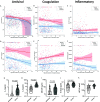Inflammatory profiles across the spectrum of disease reveal a distinct role for GM-CSF in severe COVID-19
- PMID: 33692097
- PMCID: PMC8128298
- DOI: 10.1126/sciimmunol.abg9873
Inflammatory profiles across the spectrum of disease reveal a distinct role for GM-CSF in severe COVID-19
Abstract
While it is now widely accepted that host inflammatory responses contribute to lung injury, the pathways that drive severity and distinguish coronavirus disease 2019 (COVID-19) from other viral lung diseases remain poorly characterized. We analyzed plasma samples from 471 hospitalized patients recruited through the prospective multicenter ISARIC4C study and 39 outpatients with mild disease, enabling extensive characterization of responses across a full spectrum of COVID-19 severity. Progressive elevation of levels of numerous inflammatory cytokines and chemokines (including IL-6, CXCL10, and GM-CSF) were associated with severity and accompanied by elevated markers of endothelial injury and thrombosis. Principal component and network analyses demonstrated central roles for IL-6 and GM-CSF in COVID-19 pathogenesis. Comparing these profiles to archived samples from patients with fatal influenza, IL-6 was equally elevated in both conditions whereas GM-CSF was prominent only in COVID-19. These findings further identify the key inflammatory, thrombotic, and vascular factors that characterize and distinguish severe and fatal COVID-19.
Copyright © 2021, American Association for the Advancement of Science.
Figures





References
-
- Huang C., Wang Y., Li X., Ren L., Zhao J., Hu Y., Zhang L., Fan G., Xu J., Gu X., Cheng Z., Yu T., Xia J., Wei Y., Wu W., Xie X., Yin W., Li H., Liu M., Xiao Y., Gao H., Guo L., Xie J., Wang G., Jiang R., Gao Z., Jin Q., Wang J., Cao B., Clinical features of patients infected with 2019 novel coronavirus in Wuhan, China. Lancet 395, 497–506 (2020). 10.1016/S0140-6736(20)30183-5 - DOI - PMC - PubMed
-
- Leisman D. E., Ronner L., Pinotti R., Taylor M. D., Sinha P., Calfee C. S., Hirayama A. V., Mastroiani F., Turtle C. J., Harhay M. O., Legrand M., Deutschman C. S., Cytokine elevation in severe and critical COVID-19: A rapid systematic review, meta-analysis, and comparison with other inflammatory syndromes. Lancet Respir. Med. 8, 1233–1244 (2020). 10.1016/S2213-2600(20)30404-5 - DOI - PMC - PubMed
Publication types
MeSH terms
Substances
Grants and funding
- MC_PC_19025/MRC_/Medical Research Council/United Kingdom
- G0701652/MRC_/Medical Research Council/United Kingdom
- MR/P502091/1/MRC_/Medical Research Council/United Kingdom
- 205228/Z/16/Z/WT_/Wellcome Trust/United Kingdom
- MC_PC_19059/MRC_/Medical Research Council/United Kingdom
- MC_PC_19078/MRC_/Medical Research Council/United Kingdom
- 215091/Z/18/Z/WT_/Wellcome Trust/United Kingdom
- MC_PC_20060/MRC_/Medical Research Council/United Kingdom
- MR/R502121/1/MRC_/Medical Research Council/United Kingdom
- MR/S032304/1/MRC_/Medical Research Council/United Kingdom
- MR/V028448/1/MRC_/Medical Research Council/United Kingdom
- MR/T50256X/1/MRC_/Medical Research Council/United Kingdom
- MRF-159-0001-ELP-HUNT/MRF_/MRF_/United Kingdom
LinkOut - more resources
Full Text Sources
Other Literature Sources
Medical

